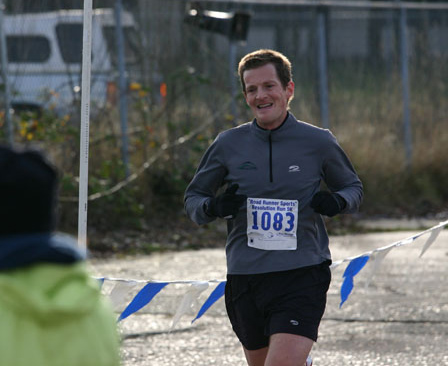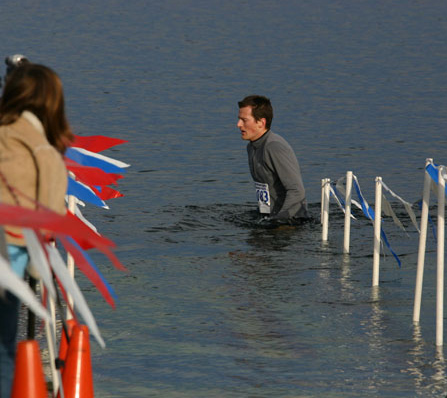“Where the hell did you come from?” That was Michael Arnstein’s question as I pulled even with him during the 49th mile of the JFK 50.
Michael’s surprise was understandable, for he had been gliding toward an apparent victory for quite some time while I slowly reeled in the people behind him. After a cautious traverse of the 15.5-mile Appalachian Trail section of the course, I was in about 15th place, seven minutes behind the leaders. It wasn’t until mile 25 or so that I broke into the top ten and mile 35 or so that I entered the top five. I finally overtook 2nd place (Matt Woods, running his first-ever 50-miler) at mile 40 or 41. I was three minutes behind Michael at that point, and when told at mile 44 that I was still three minutes behind him, I gave up on the idea of winning. I was working really hard to run 6:50 miles over rolling country roads, and without a target in sight, I couldn’t go any faster.
Then at mile 46 I was told that the lead was down to 2:11, and the chase was on again. I accelerated, brought Michael into view, accelerated some more, and hunted him down like the cold-blooded killer I can be in such situations. Poor guy. I wound up with the narrowest margin of victory in the 47-year history of the race, 45 seconds, and the second-fastest time in race history, 5:50:13. It was undoubtedly the most exciting ultramarathon finish of my life, and I think the photographic evidence will confirm that I broke the tape with a huge smile on my face.
So how exactly did this happen? To start with, I think my fall training avoided some previous mistakes. For example, I shortened my long-and-hard runs a bit to avoid trashing my legs as much as in the past. I still tried to run near race pace along routes that roughly resembled the race course, but I gave myself more flexibility (in terms of both pace and venue) than before so as to make the training more enjoyable.
As for the race itself, there was a certain amount of luck involved, but I also credit myself for being very, very patient. I knew that I couldn’t stay with the leaders on the rocky Appalachian Trail, so I let them go without getting too stressed out about it. Then when I reached the flat, wide towpath that constitutes the middle 26.3 miles of the race, I resisted the urge to make up lots of ground quickly, instead letting myself ease into the faster pace. I also resisted the urge to check my splits every mile using the towpath’s mile markers, which likewise would have added more stress.
Finally, although it’s obvious that I and all ultrarunners depend on support from spouses, friends, race volunteers, etc., today’s race provided a particularly striking example of this. My friend Henry Wigglesworth, a former Seattle resident now living in Washington DC, served as my handler. At each of the five aid stations where personal handlers were permitted, he had my drinks and food ready so that I didn’t have to fend for myself or convey my needs to the aid station volunteers (who were great, by the way). He probably saved me an average of 12 seconds per aid station. If you recall that my margin of victory was 45 seconds, it is not much of a stretch to say that I won the race because of Henry.





